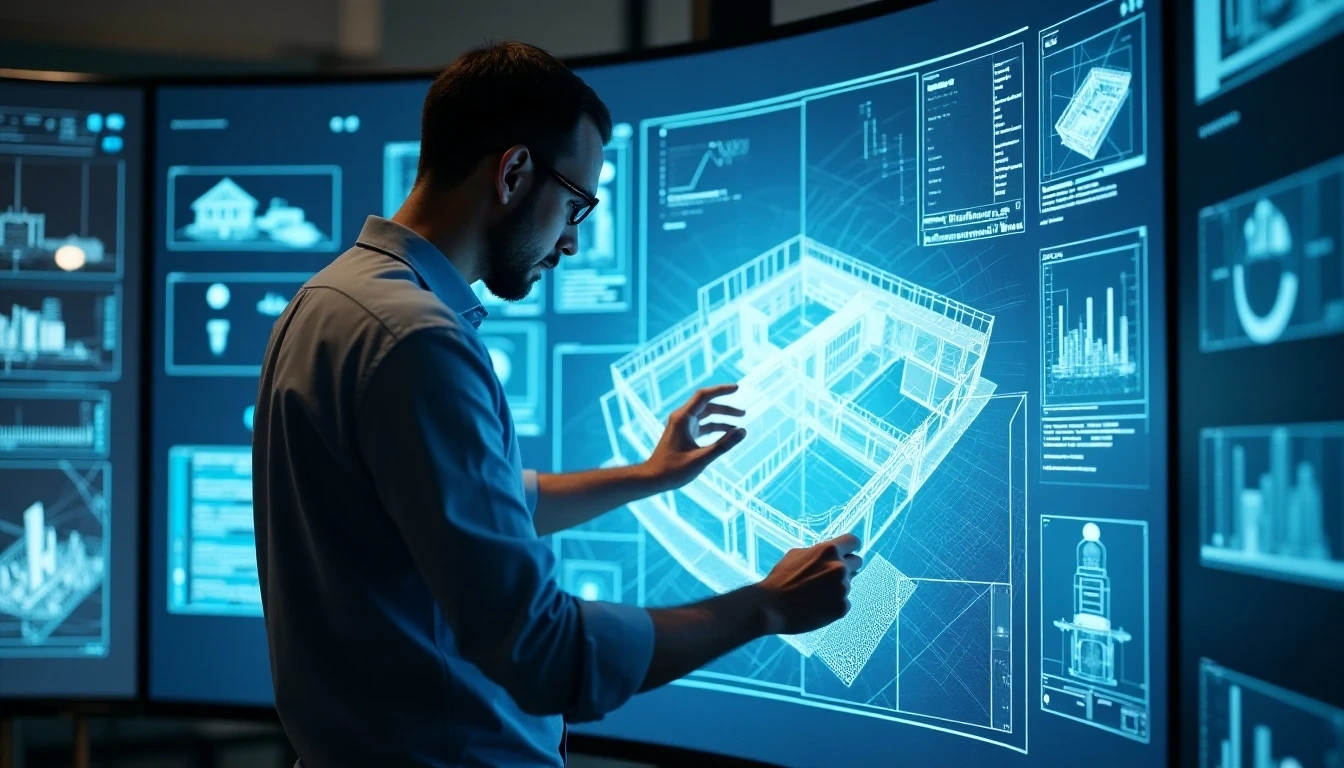How Architects Use AI 3D Tools to Improve Efficiency: 2025 Latest Practice Guide
The architectural design industry is undergoing digital transformation, and AI 3D generation technology brings unprecedented efficiency improvements for architects and interior designers. From concept design to client presentations, from decorative elements to spatial layouts, AI tools are redefining architectural design workflows.

3D Modeling Challenges in Architectural Design
Pain Points of Traditional Architectural 3D Modeling
In traditional architectural design workflows, 3D modeling is often one of the most time-consuming aspects. For a medium-sized residential project, modeling decorative elements alone can take weeks. This includes precise modeling of hundreds of small objects like furniture, lighting, decorations, and plants.
An even bigger challenge is client communication. Architects need to help non-professional clients understand design proposals, while traditional floor plans and elevations often fail to convey complete spatial experiences. High-quality 3D visualization becomes essential, but production costs and time costs are both high.
Human Resource Cost Pressure

Professional architectural 3D modelers command substantial salaries, creating significant burden for small and medium-sized design firms. Moreover, different projects require different style approaches, making it often impractical to maintain a full-time 3D team.
Application Value of AI 3D Tools in Architectural Design
Rapid Concept Visualization
AI platforms like Open3D.art enable architects to transform creative ideas into 3D models within 30 seconds. When you need to show clients a decorative scheme, simply describe "a modern minimalist living room coffee table, white marble top, metal frame" to instantly generate a visualization model.
Dramatically Reduce Design Costs
Free AI generation and download functions make design costs nearly zero. A complete interior design project might require hundreds of decorative models, with traditional production costs potentially reaching tens of thousands of dollars, while AI generation is completely free.
Improve Client Communication Efficiency
3D models are more intuitive than any text description. When explaining design concepts to clients, real-time generated 3D models can immediately demonstrate effects, greatly improving communication efficiency and client satisfaction.
AI Application Strategies for Different Design Stages
Schematic Design Stage
Concept Exploration:
- Rapidly generate decorative schemes in multiple styles
- Test different material and color combinations
- Provide clients with rich choices
Spatial Layout:
- Generate furniture models in different sizes
- Test spatial proportion relationships
- Validate design feasibility
Design Development Stage
Detailed Decoration: Use more precise prompts to generate specific decorative elements:
- "A Nordic-style pendant light, white metal shade, suitable for dining room use, 80cm height"
- "A set of modern-style decorative paintings, abstract geometric patterns, suitable for living room walls"
Material Expression:
- Generate models with different material effects
- Help clients understand material choices
- Preview final effects
Construction Documentation Stage
Detail Drawings:
- Generate 3D detail drawings of complex nodes
- Help construction teams understand design intent
- Reduce construction errors
Specific Application Scenarios in Interior Design
Residential Space Design
Living Room Design:
- Sofa combinations: "A modern minimalist sofa set, gray fabric upholstery, L-shaped layout, suitable for 25 sqm living room"
- Coffee table configuration: "A round glass coffee table, metal frame, 120cm diameter, 40cm height"
- Decorative objects: "A modern art vase, ceramic material, matte white, 30cm height"
Bedroom Design:
- Bed selection: "A modern-style double bed, upholstered headboard, beige fabric, 1.8m wide"
- Storage furniture: "A walk-in closet, white door panels, reasonable interior partitioning"
- Lighting design: "A warm bedside lamp, warm color tone, suitable for reading"
Kitchen Design:
- Cabinet configuration: "A modern kitchen cabinet set, white door panels, quartz countertops"
- Appliance integration: "A built-in oven, stainless steel appearance, suitable for modern kitchens"
Commercial Space Design
Office Spaces:
- Office furniture: "A modern office desk, white desktop, steel frame, clean design"
- Conference facilities: "A conference table and chair set, modern business style, suitable for 8 people"
- Lounge areas: "An office lounge sofa, modern style, suitable for employee relaxation"
Dining Spaces:
- Tables and chairs: "A restaurant table and chair set, industrial style, suitable for cafe use"
- Bar design: "A modern bar counter, marble top, high stool set"
- Decorative elements: "An industrial-style pendant light, black metal material, suitable for restaurants"
Integration with Traditional Architectural Software
CAD Software Integration
AutoCAD:
- Import AI-generated models as block references
- Use for furniture layout in floor plans
- Rapidly generate standardized blocks
SketchUp:
- Directly import OBJ format models
- Integrate with existing model libraries
- Quickly build spatial scenes
BIM Software Applications
Revit:
- Create custom family files
- Enrich project model libraries
- Improve BIM model completeness
ArchiCAD:
- Import as GDL objects
- Expand built-in object libraries
- Enhance visualization effects
Rendering Software Optimization
3ds Max + V-Ray:
- Optimize model topology
- Adjust materials and textures
- Create high-quality renderings
Lumion:
- Import directly for real-time rendering
- Create architectural animations
- Rapid presentation output
Application Tips for Enhancing Client Experience
Real-Time Design Presentation
During client meetings, generate 3D models on-site:
- Client expresses requirements
- Input prompts in real-time
- Display 3D effects within 30 seconds
- Adjust proposals based on feedback
This interactive design process greatly enhances client engagement and satisfaction.
Multi-Option Comparisons
Rapidly generate decorative schemes in multiple styles for the same space:
- Modern minimalist style
- Nordic style
- Industrial style
- Modern Chinese style
Allow clients to compare intuitively and make quick decisions.
Cost Control Demonstrations
Generate decorative schemes at different price points to help clients make optimal choices within budget:
- Economic schemes
- Standard schemes
- Luxury schemes
Quality Control and Optimization Strategies
Model Quality Inspection
AI-generated models require quality checks:
- Proportion Accuracy: Ensure model dimensions meet actual requirements
- Material Authenticity: Check if material expression meets design requirements
- Detail Completeness: Evaluate if model details satisfy presentation needs
Post-Processing Optimization Workflow
- Size Adjustment: Adjust model dimensions based on actual spatial requirements
- Material Optimization: Adjust material parameters in rendering software
- Texture Processing: Add or modify textures to match design style
- Lighting Adaptation: Adjust models to suit scene lighting
Cost-Benefit Analysis
Time Cost Comparison
Traditional Methods:
- Decorative model creation: 2-5 days per item
- Scheme adjustments: 1-2 days
- Client communication: Multiple rounds
AI-Assisted Methods:
- Model generation: 30 seconds per item
- Scheme adjustments: Real-time
- Client communication: One-time completion
Economic Benefits
Cost Savings:
- Reduce 3D modeler human resource costs
- Shorten project cycles
- Improve client satisfaction
Increased Revenue:
- Enhance design quality
- Expand service scope
- Strengthen competitive advantages
Legal and Professional Considerations
Copyright Issues
AI-generated decorative models can be used in commercial projects, but note:
- Confirm platform commercial use terms
- Retain generation records
- Avoid infringing others' design copyrights
Professional Development
Architects who master AI tools will have significant advantages:
- Improve work efficiency
- Expand service capabilities
- Adapt to industry development trends
Real Project Case Studies
Case 1: High-End Residential Interior Design
A designer used AI tools to design complete decorative schemes for a 200 sqm high-end residence. Generated all decorative elements for living rooms, bedrooms, studies, and other spaces through AI, including furniture, lighting, decorations, totaling 150 models.
Results:
- Design time reduced from 2 weeks to 3 days
- Client satisfaction significantly improved
- Project profit margin increased by 30%
Case 2: Commercial Office Space
A design company used AI tools to design office space for a technology company. Rapidly generated various modern office furniture and decorative elements, helping clients intuitively understand design proposals.
Results:
- Proposal presentation passed in one round
- Reduced 5 design revisions
- Completed design tasks one week ahead of schedule
Future Development Trends
Technology Development Directions
- Precision Enhancement: AI-generated models will become more accurate
- Material Enhancement: Support more complex material expressions
- Style Diversification: Cover more architectural styles
Industry Application Expansion
- Intelligent Design: AI automatically generates overall design schemes
- VR Integration: Combine with virtual reality technology
- Construction Guidance: Generate construction guidance models
Getting Started with AI 3D Tools
If you're an architect or interior designer, we recommend immediately starting to try AI 3D tools:
- Start Simple: First generate some basic decorative models
- Establish Workflow: Gradually integrate AI tools into existing workflows
- Accumulate Experience: Gain experience through actual projects
- Expand Applications: Explore more innovative application methods
Visit Open3D.art to begin your AI-assisted design journey. In this rapidly changing design industry, designers who master AI tools will gain significant competitive advantages.
Don't let technical barriers hinder your creative expression—let AI become your powerful assistant in realizing design visions. The future of architectural design will be more efficient and more exciting, and this future starts now.